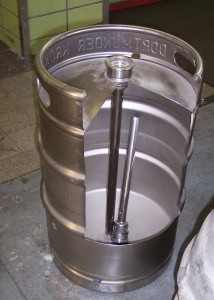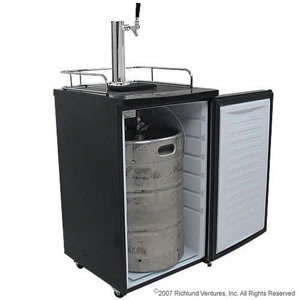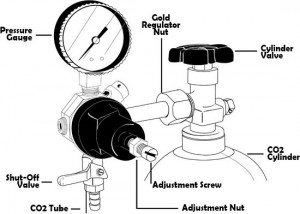CHE 324 Process Controls Project – Kegerator
Kegs have played an integral role in the storage, transportation and dispensing of beverages for many years. Historically, kegs were constructed using wood but nowadays they are typically made of stainless steel. A keg, or half-barrel is a 15.5 U.S. gallon vessel. A quarter-barrel has a volume of 7.75 U.S. gallons. Generally a keg is a vessel smaller than a barrel; thus, it is 30 gallons or smaller. A manual pump is used to generate pressure, pushing the beverage out of a hose. Keeping the liquids somewhat insulated, and allowing easy access; a keg is a great way to serve beverages at social gatherings.

Figure 1 – Inner view of a Keg
Unfortunately, kegs do have a few shortcomings. While they do provide some degree of insulation, they cannot cool the beverage or control the temperature. A traditional keg also requires manual pumping, which can be tiresome and waste time. These issues can be solved with a Kegerator, a specialized refrigerator built to work with kegs. Kegerators are generally designed for use with kegs, but they are gaining popularity for dispensing other types of drinks, most notably wine, cold brewed coffee, kombucha, and soda. With home brew kegs, you can put whatever liquid you want inside the keg, pressurize it and dispense it with a kegerator. Different types of liquids require different alterations to the dispense system. Wine and cold brewed coffee use a CO2/Nitrogen blend to pressurize the kegs. These types of drinks also require all stainless steel contact with the dispense system fittings because the higher acid content can corrode the chrome plated brass normally found in dispense systems.A kegerator has a built in control system to regulate temperature, working just like a typical refrigerator. To add pressure, a compressed gas tank is attached instead of manual pumping. A gas mixture, high in CO2, is sent through a regulator to keep the contents of the keg at constant pressure, so the beverage will be dispensed when a valve is opened.
A kegerator solves many of the issues associated with a typical keg, but we believe the system could be improved further. With a kegerator, careful care must be taken to maintain proper levels of dissolved carbon dioxide. Typically, a user first chooses a temperature as a set point for the system. At that given temperature, the regulator pressure must be set to a specific value to ensure the right amount of carbonation in the beverage. This is not the most direct way of controlling CO2 levels, and also means that the user cannot adjust pressure levels as they like to alter the flow rate of the beverage out of the keg. Because of this, at low pressure settings the beverage is pumped out too slowly for a social gathering with many people and at high pressure settings the turbulent flow out of the hose causes too much foam.

Figure 2 – Kegerator
We believe that with a few modifications to the design, and an added control system, we could make improvements to the Kegerator. These improvements would would exponentially enhance the experience of the consumers, as CO2 increases the life of the beverage and temperature further enhances its taste. Further temperature has a formidable effect on both viscosity and solubility of the liquid.
As the temperature of a solution is increased, the average kinetic energy of the molecules that make up the solution also increases. This increase in kinetic energy allows the solvent molecules to more effectively break apart the solute molecules that are held together by intermolecular attractions. The average kinetic energy of the solute molecules also increases with temperature, and it destabilizes the solid state. The increased vibration (kinetic energy) of the solute molecules causes them to be less able to hold together, and thus they dissolve more readily. The impact of increasing temperature will be to slow down the sphere in gases and to accelerate it in liquids. When you consider a liquid at room temperature, the molecules are tightly bound together by attractive inter-molecular forces (e.g. Van der Waal forces). It is these attractive forces that are responsible for the viscosity since it is difficult for individual molecules to move because they are tightly bound to their neighbors. The increase in temperature causes the kinetic or thermal energy to increase and the molecules become more mobile. The attractive binding energy is reduced and therefore the viscosity is reduced. If you continue to heat the liquid the kinetic energy will exceed the binding energy and molecules will escape from the liquid and it can become a vapor.
Typically, a gas will increase in solubility with an increase in pressure. This effect can be mathematically described using an equation called Henry’s Law. When a gas is dissolved in a liquid, pressure has an important effect on the solubility. William Henry, an English chemist, showed that the solubility of a gas increased with increasing pressure. He discovered the following relationship:
C = k * Pgas
In this equation, C is the concentration of the gas in solution, which is a measure of its solubility, k is a proportionality constant that has been experimentally determined, and Pgas is the partial pressure of the gas above the solution. The proportionality constant needs to be experimentally determined because the increase in solubility will depend on which kind of gas is being dissolved.
The goal of this control system would be to keep temperature and dissolved carbon dioxide levels in the beverage (the controlled variables) as close as possible to a desired set point, as well as to give the user the ability to adjust the pressure in the keg as desired. Operating ranges for temperature and CO2 level are based off of the user’s preferences. Guidelines for these are often provided by the manufacturer of the beverage. While controlling this system is very critical for it to function, it will add enjoyment to the user’s experience.
We plan on optimizing the Kegerator by adding a nitrogen tank in addition to the existing carbon dioxide tank. Both tanks will have a valve (that can be turned to varying degrees of openness) linked to a controller. After the valve, both tanks will have a regulator (set to the same pressure). These lines will both feed into the keg. A sensor to detect dissolved carbon dioxide in the beverage can be placed inside the keg. The refrigeration unit acts exactly as a typical mini-fridge. A display on the outside will allow the user to specify a set point for temperature and dissolved CO2 levels. Therefore, this system would employ a feed back loop, wherein the temperature and CO2 levels in the kegerator would be constantly monitored. If these values fall outside the user’s preference, the manipulated variables would be signaled. The major advantage of such a feed back system is that it’s reactive to disturbances in the surroundings, as it automatically compensates for any such differences by manipulating the required variables.

Figure 3 – CO2 Regulator
For this system, manipulated variables are the electrical power sent to the compressor and the valve positions for the nitrogen and carbon dioxide tanks. Pressure in the tank could possibly be considered another controlled variable and in this case, the manipulated variable would be the regulator openness, with the user acting as the controller.
A few disturbance variables exist for this application, too. Changes in temperature surrounding the system could affect the temperature of the contents of the keg. Changes in outside temperature could also affect the pressure and flow rate of the gas from the tanks. Finally, changes in altitude could affect pressure and the desired carbon dioxide levels in the beverage.
References
“How to Make Cold Brew Iced Coffee.” How to Make Cold Brew Iced Coffee. N.p., n.d. Web. 31 Mar. 2016.
“Solid Solubility and Temperature – Boundless Open Textbook.” Boundless. N.p., n.d. Web. 31 Mar. 2016.
“How Does Temperature Change Viscosity in Liquids and Gases?” How Does Temperature Change Viscosity in Liquids and Gases? N.p., n.d. Web. 31 Mar. 2016.